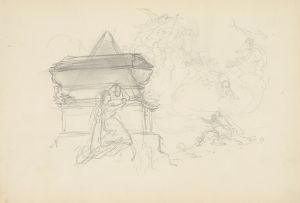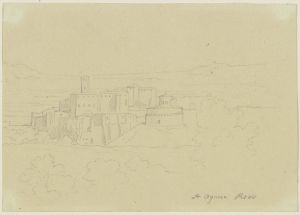
Viaticum
A hand-painted replica of Henryk Siemiradzki’s masterpiece Viaticum, meticulously crafted by professional artists to capture the true essence of the original. Each piece is created with museum-quality canvas and rare mineral pigments, carefully painted by experienced artists with delicate brushstrokes and rich, layered colors to perfectly recreate the texture of the original artwork. Unlike machine-printed reproductions, this hand-painted version brings the painting to life, infused with the artist’s emotions and skill in every stroke. Whether for personal collection or home decoration, it instantly elevates the artistic atmosphere of any space.
Henryk Siemiradzki's "Viaticum" is a notable painting by the Polish artist, renowned for his large-scale historical and genre scenes. Siemiradzki, born in 1843 in the Russian Empire, which is now part of Ukraine, was a prominent figure in the 19th-century art world. He was known for his academic style and his ability to capture the grandeur and complexity of historical and biblical themes.
"Viaticum" is a term that refers to the Eucharist given to a person who is dying, often seen as a spiritual provision for the journey from life to death. This theme is reflective of Siemiradzki's interest in religious and philosophical subjects, which he often explored through his art. The painting, like many of Siemiradzki's works, is characterized by its meticulous attention to detail, vibrant use of color, and dramatic composition.
Siemiradzki was educated at the Imperial Academy of Arts in Saint Petersburg and later continued his studies in Munich and Rome. His time in Rome was particularly influential, as it exposed him to the classical art and architecture that would heavily influence his work. The artist's style is often associated with the academic tradition, which emphasized technical skill and adherence to classical ideals.
"Viaticum" exemplifies Siemiradzki's mastery of light and shadow, a technique he used to create depth and emotion in his paintings. His works often feature a strong narrative element, inviting viewers to engage with the story being depicted. In "Viaticum," this narrative quality is evident as the painting captures a poignant moment of spiritual significance.
Siemiradzki's paintings were well-received during his lifetime, earning him numerous accolades and commissions. He was a member of several prestigious art academies across Europe and was awarded the Legion of Honour in France. His works were exhibited widely, and he enjoyed considerable success both in his homeland and abroad.
The artist's legacy is preserved in various museums and collections, with "Viaticum" being part of this enduring heritage. Siemiradzki's influence can be seen in the works of later artists who admired his ability to blend historical accuracy with artistic imagination.
While specific details about the creation and current location of "Viaticum" may not be extensively documented, the painting remains an important part of Siemiradzki's oeuvre. It reflects his fascination with the intersection of life, death, and spirituality, themes that resonate throughout his body of work.
Siemiradzki passed away in 1902, but his contributions to the art world continue to be celebrated. His paintings, including "Viaticum," are appreciated for their technical brilliance and the depth of emotion they convey. Through his art, Siemiradzki offers a window into the cultural and historical contexts of his time, providing insight into the values and beliefs that shaped his world.


















